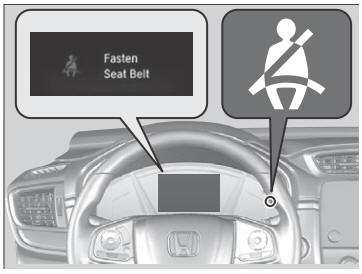Honda CR-V: When Driving / Tire Pressure Monitoring System (TPMS)
Instead of directly measuring the pressure in each tire, the TPMS on this vehicle monitors and compares the rolling radius and rotational characteristics of each wheel and tire while you are driving to determine if one or more tires are significantly under-inflated.
This will cause the low tire pressure/TPMS indicator to come on and a message to appear on the driver information interface.
https://www.aestroi.com в пионерском начали ремонт историческои виллы.
The system does not monitor the tires when driving at low speed.
Conditions such as low ambient temperature and altitude change directly affect tire pressure and can trigger the low tire pressure/TPMS indicator to come on.
Tire pressure checked and inflated in:
- Warm weather can become under-inflated in colder weather.
- Cold weather can become over-inflated in warmer weather.
The low tire pressure indicator will not come on as a result of over inflation.
The TPMS may not function properly if tire type and size are mixed. Make sure to use the same size and type of tire.
The low tire pressure/TPMS indicator may come on with a delay or may not come on at all when:
- You rapidly accelerate, decelerate, or turn the steering wheel.
- You drive on snowy or slippery roads.
- Snow chains are used.
The low tire pressure/TPMS indicator may come on under the following conditions:
- A compact spare tire is used.
- There is a heavier and uneven load on the tires, such as when towing a trailer, than the condition at calibration.
- Snow chains are used.
 Real Time AWD with Intelligent Control System™*
Real Time AWD with Intelligent Control System™*
* Not available on all models
When the system senses a loss of front wheel traction, it automatically
transfers
some power to the rear wheels. This allows you to utilize all available traction
and
may increase mobility...
 TPMS Calibration
TPMS Calibration
You must start TPMS calibration every time you:
Adjust the pressure in one or more tires.
Rotate the tires.
Replace one or more tires.
Before calibrating the TPMS:
Set the cold tire pressure in all four tires...
Other information:
Honda CR-V 2017-2025 Owner's Manual: Locking/Unlocking the Doors Using a Key
If the smart entry remote battery or the vehicle battery is dead, use the key instead of the smart entry remote. Fully insert the key and turn it. When you lock the driver's door with a key, all the other doors and tailgate lock at the same time. When unlocking, the driver's door unlocks first...
Honda CR-V 2017-2025 Owner's Manual: Smart Entry Remote Reminder
Warning buzzers may sound from inside or/ and outside the vehicle to remind you that the smart entry remote is out of the vehicle. If the buzzer continues even after the remote is put back inside, place it within the system's operational range...
Categories
- Manuals Home
- Honda CR-V Owners Manual
- Honda CR-V Service Manual
- Oil Check
- Odometer and Trip Meter
- Front Seats
- New on site
- Most important about car
Seat Belt Reminder

The seat belt system includes an indicator on the instrument panel to remind the driver or a front passenger or both to fasten their seat belts.
If the ignition switch is turned to ON
 *1 and
a seat belt is not fastened, a beeper will sound
and the indicator will blink. After a few
seconds, the beeper will stop and the
indicator will come on and remain illuminated
until the seat belt is fastened.
*1 and
a seat belt is not fastened, a beeper will sound
and the indicator will blink. After a few
seconds, the beeper will stop and the
indicator will come on and remain illuminated
until the seat belt is fastened.
